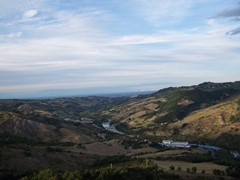Marano sul Panaro and the domination of the Montecuccoli
The little town of Marano lies in the attractive Panaro river valley, a real splendour during the spring when thousands of fruit trees blossom, hence its nickname, “Cherry Tree Valley”. Its history dates back to before the year One Thousand AD; in fact it first receives mention in a document from the year 887 as belonging to Nonantola Abbey. However the foundation of the town is linked to the nearby area called Castiglione, already mentioned in 752 in a donation by Aistulf, King of the Lombards.
Marano had a rather turbulent life: it was the subject of continuous bloody struggles of conquest between factions from Modena and Bologna and changed hands constantly between the many local noble feudatories, from the Rangone to the Pio and the Pico, until in 1630 it was granted in investiture to Marquis Francesco Montecuccoli, the elder House Steward of Duke Francesco I d'Este. Under the munificent Montecuccoli, Marano achieved great prosperity.
It is said that the celebrated Marshall Raimondo Montecuccoli on returning from the battle of Raab against the Turks, left his standards in the old local church.
The oldest part of the town extends towards the hills with houses of a medieval appearance. Of interest is the Oratory of Sant Antonio da Padova, from the 16th century, and a vast 18th century building known locally as “the convent”. The top of the hill was dominated by the Castle of the Montecuccoli, of which just a few remains of the walls exist.
In Marano’s main square, near the Town Hall and the Parish Church is the ancient Montecuccoli Mill, built by the feudatory family of the same name in 1654. In 1907, even though it was still in working order, the building became home to a power station, which in 1923 was taken over by the local electricity board and later by the national board ENEL, which used its machinery until 1973. At the end, the Municipality, the last owner, had it restored, finishing in 1994, and returning to its former glory the portico with its rounded arches and hemispherical vaults. The rooms on the first floor are now home to Marano’s “Museum of Ecology and Natural History”, while those on the ground floor house a documentation centre on hydroelectric production.
Worth a mention is the Marano canal, once called the Montecuccoli Canal, which was mentioned in 1319 in a deed of Bishop Guido with which he granted permission to build a mill on its course. The Marano canal begins just behind the town, runs alongside the River Panaro and then, for a short stretch undercover, along and below the town ring road and Via Roma, as far as Palazzo Montecuccoli where, with an effective jump in level of around three metres, it feeds a hydroelectric plant. It then runs on for about another 5km, with an overall difference in level of about 20 metres, to cross the countryside as far as Vignola. The Canal empties once again into the River Panaro at Vignola, just behind the inlet of the San Pietro canal which arrives as far as Modena. For centuries the Marano canal provided the energy to grind wheat as well as water to irrigate the fields, allowing local agriculture to flourish.
Near the town, on the Zenzano road, we find the so-called “Colombarone”, an imposing building surmounted by an impressive dovecot in the form of a tower. This is major rural complex of Renaissance origin, whose interesting structure features the contemporary presence of service rooms, dwellings for the servants and apartments for the owners. Access to the latter is marked by a marble bas-relief that reproduces the noble crest of the Montecuccoli family, who used the Colombarone as their country residence. The building, now privately owned, dates back to the 17th century, but was significantly enlarged in the 1800s.
